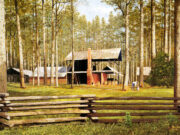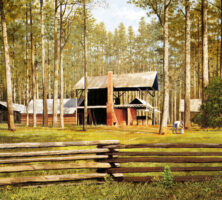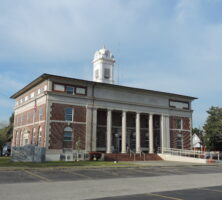Atkinson County, Georgia’s 153rd county, covers an area of 338 square miles and was carved from portions of Clinch and Coffee counties by the state legislature in 1917. The south central Georgia county was named for William Y. Atkinson, speaker of the state House of Representatives and Georgia’s governor in the late 1890s.
The region was originally inhabited by Creek Indians, who forged a trail through the southern part of the area that was later used by traders between the Flint River and the coastal town of St. Marys. This trail was known as the “Kinnaird Trail” for a trading post managed by Jack Kinnaird at its western limit. It was along the Kinnaird Trail that the first white settlers traveled from middle Georgia, Tennessee, North Carolina, and South Carolina, arriving after the Revolutionary War (1775-83). The Brunswick and Albany Railroad laid its track along portions of the trail after the Civil War (1861-65), and the rail reached Pearson, the county seat, by the 1870s.

Pearson was incorporated in December 1890, and the county courthouse was built there in 1920. The courthouse was placed on the National Register of Historic Places in 1980. Other towns in the county are Axson, Kirkland, and Willacoochee. Axson, called McDonald’s Mill before the creation of Atkinson County, was renamed in honor of U.S. president Woodrow Wilson’s first wife, Ellen Axson Wilson (of Rome) when the new county was created. Willacoochee, founded in 1889, was the first chartered town in the county. The town has one building, McCranie’s Turpentine Still, listed on the National Register of Historic Places. The still was active in Willacoochee from 1925 to 1949.
Early industry in Atkinson County depended on the pine forests covering much of the land. Logging operations used the Satilla River to float timber to the coast. Later, farming (tobacco, corn, and poultry) displaced logging as the central economic activity. Poultry continues to be an important industry, and the main agricultural crops are peanuts, cotton, corn, and tobacco.

According to the 2020 U.S. census, the county population is 8,286, an increase over the 2000 population of 7,609. In the 1990s immigrants from Latin America moved into the county to work in the mobile-home industry and in agriculture.
Among the points of interest are the Columbus Salt Road, the Kinnaird Trail, and the Minnie F. Corbitt Memorial Museum, established in 1955 and located in the first house in Pearson, built in 1873.








